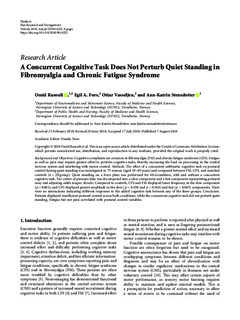| dc.contributor.author | Rasouli, Omid | |
| dc.contributor.author | Fors, Egil Andreas | |
| dc.contributor.author | Vasseljen, Ottar | |
| dc.contributor.author | Stensdotter, Ann-Katrin | |
| dc.date.accessioned | 2018-09-04T08:30:19Z | |
| dc.date.available | 2018-09-04T08:30:19Z | |
| dc.date.created | 2018-07-26T22:58:54Z | |
| dc.date.issued | 2018 | |
| dc.identifier.citation | Pain Research & Management. 2018, 1-8. | nb_NO |
| dc.identifier.issn | 1203-6765 | |
| dc.identifier.uri | http://hdl.handle.net/11250/2560612 | |
| dc.description.abstract | Background and Objectives. Cognitive complaints are common in fibromyalgia (FM) and chronic fatigue syndrome (CFS). Fatigue as well as pain may require greater effort to perform cognitive tasks, thereby increasing the load on processing in the central nervous system and interfering with motor control. Methods. The effect of a concurrent arithmetic cognitive task on postural control during quiet standing was investigated in 75 women (aged 19–49 years) and compared between FM, CFS, and matched controls (/group). Quiet standing on a force plate was performed for 60 s/condition, with and without a concurrent cognitive task. The center of pressure data was decomposed into a slow component and a fast component representing postural sway and adjusting ankle torque. Results. Compared to controls, CFS and FM displayed lower frequency in the slow component (), and CFS displayed greater amplitude in the slow ( and ) and fast () components. There were no interactions indicating different responses to the added cognitive task between any of the three groups. Conclusion. Patients displayed insufficient postural control across both conditions, while the concurrent cognitive task did not perturb quiet standing. Fatigue but not pain correlated with postural control variables. | nb_NO |
| dc.language.iso | eng | nb_NO |
| dc.publisher | Hindawi Publishing Corporation | nb_NO |
| dc.rights | Navngivelse 4.0 Internasjonal | * |
| dc.rights.uri | http://creativecommons.org/licenses/by/4.0/deed.no | * |
| dc.title | A concurrent cognitive task does not perturb quiet standing in fibromyalgia and chronic fatigue syndrome | nb_NO |
| dc.type | Journal article | nb_NO |
| dc.type | Peer reviewed | nb_NO |
| dc.description.version | publishedVersion | nb_NO |
| dc.source.pagenumber | 1-8 | nb_NO |
| dc.source.journal | Pain Research & Management | nb_NO |
| dc.identifier.doi | 10.1155/2018/9014232 | |
| dc.identifier.cristin | 1598781 | |
| dc.description.localcode | © 2018 Omid Rasouli et al. This is an open access article distributed under the Creative Commons Attribution License, which permits unrestricted use, distribution, and reproduction in any medium, provided the original work is properly cited. | nb_NO |
| cristin.unitcode | 194,65,30,0 | |
| cristin.unitcode | 194,65,20,0 | |
| cristin.unitname | Institutt for nevromedisin og bevegelsesvitenskap | |
| cristin.unitname | Institutt for samfunnsmedisin og sykepleie | |
| cristin.ispublished | true | |
| cristin.fulltext | original | |
| cristin.qualitycode | 1 | |

